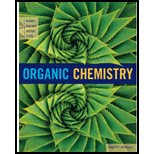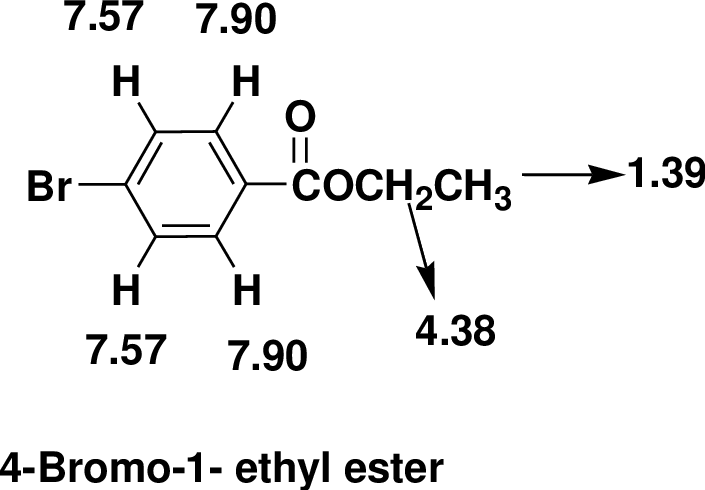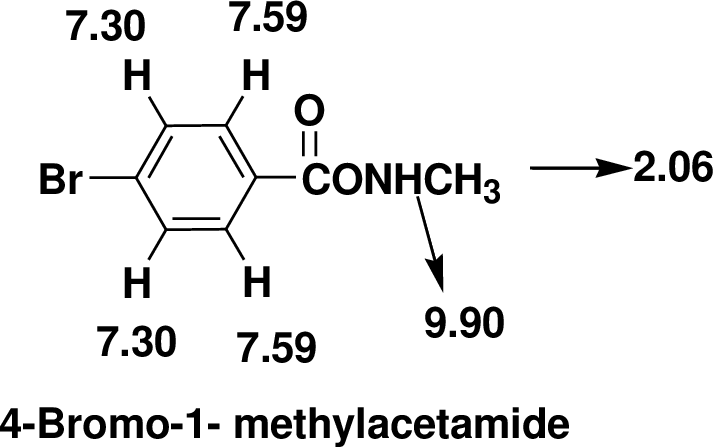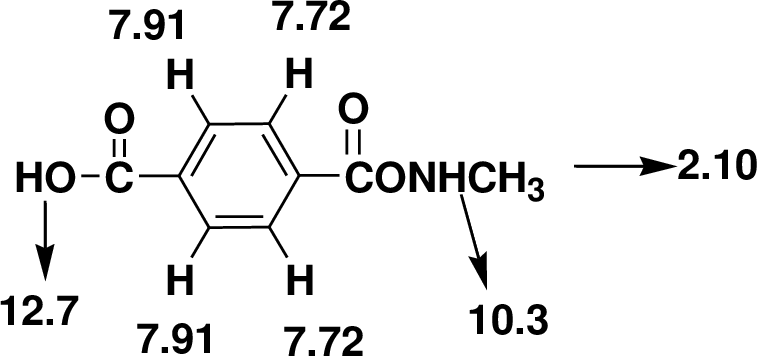
Concept explainers
(a)
Interpretation:
The strucutral formula for each of the given compound has to be proposed using the given NMR data.
Concept Introduction:
The
Chemical shift: The NMR spectrum of any compound is taken with reference to a standard compound called reference compound. Generally, tetramethylsilane (TMS) is taken as the reference compound. The methyl protons of TMS are equivalent and produces only one sharp peak at the rightmost end of the scale.
13C NMR Spectroscopy: This type of NMR splitting of signals tells us numbers of hydrogens atoms are attached to each carbon. The triangle rule (n+1) C. The chemical shift explains the different hybridization
(a)
Explanation of Solution
Index of Hydrogen Deficiency (IHD) calculation,
Given molecular formula F is
We calculate the
From the molecular formula
The one signal in the
There are also one
Therefore, the based on above spectral details the structure that is consistent with the all of these facts is 4-Bromo-1- ethyl ester.

(b)
Interpretation:
The strucutral formula for each of the given compound has to be proposed using the given NMR data.
Concept Introduction:
The
Chemical shift: The NMR spectrum of any compound is taken with reference to a standard compound called reference compound. Generally, tetramethylsilane (TMS) is taken as the reference compound. The methyl protons of TMS are equivalent and produces only one sharp peak at the rightmost end of the scale.
13C NMR Spectroscopy: This type of NMR splitting of signals tells us numbers of hydrogens atoms are attached to each carbon. The triangle rule (n+1) C. The chemical shift explains the different hybridization
(b)
Explanation of Solution
Index of Hydrogen Deficiency (IHD) calculation,
Given molecular formula F is
We calculate the
From the molecular formula
The one signal in the
There are also one
Therefore, the based on above spectral details the structure that is consistent with the all of these facts is 4-Bromo-1- methylacetamide.

(c)
Interpretation:
The strucutral formula for each of the given compound has to be proposed using the given NMR data.
Concept Introduction:
The
Chemical shift: The NMR spectrum of any compound is taken with reference to a standard compound called reference compound. Generally, tetramethylsilane (TMS) is taken as the reference compound. The methyl protons of TMS are equivalent and produces only one sharp peak at the rightmost end of the scale.
13C NMR Spectroscopy: This type of NMR splitting of signals tells us numbers of hydrogens atoms are attached to each carbon. The triangle rule (n+1) C. The chemical shift explains the different hybridization
(c)
Explanation of Solution
Index of Hydrogen Deficiency (IHD) calculation,
Given molecular formula F is
We calculate the
From the molecular formula
The one signal in the
There are also one
Therefore, the based on above spectral details the structure that is consistent with the all of these facts is acid substituted phenylacetamide.

Want to see more full solutions like this?
Chapter 21 Solutions
ORGANIC CHEMISTRY-OWL V2 ACCESS
- Can I get helpp drawing my arrowsarrow_forwardWhich of the m/z values corresponds to the base peak in the mass spectrum shown? 100 80 A. 45 B. 44 C. 29 D. 15 Intensity 20 0 10 20 30 40 B- m/z -8 50 E. 30 Which of the m/z values correspond to the molecular ion for the compound shown? A. 18 B. 82 OH C. 100 D. 102 E. 103arrow_forwardCan someone help me with drawing my arrows.arrow_forward
- I'm having trouble with converting lewis diagrams into VSEPR diagrams. I currently have this example of C2BrCl3 which I want to turn into a lewis structure, but I'm not sure what steps I need to do in order to do so. I have the table written down, however, there's two central atoms so what would I do? There seems to be 4 electron domains on the carbon atom and no lone pairs so it would seem like this shape would be tetrahedral. Here's what I have now. Thanks!arrow_forwardWe discussed the solid phase resin using in peptide synthesis. Provide a mechanism, for its formation. DRAW THE MECHANISM.arrow_forwardPlease help. Every time I've asked an expert in the past, it's been wrong :(arrow_forward
 Organic ChemistryChemistryISBN:9781305580350Author:William H. Brown, Brent L. Iverson, Eric Anslyn, Christopher S. FootePublisher:Cengage Learning
Organic ChemistryChemistryISBN:9781305580350Author:William H. Brown, Brent L. Iverson, Eric Anslyn, Christopher S. FootePublisher:Cengage Learning

